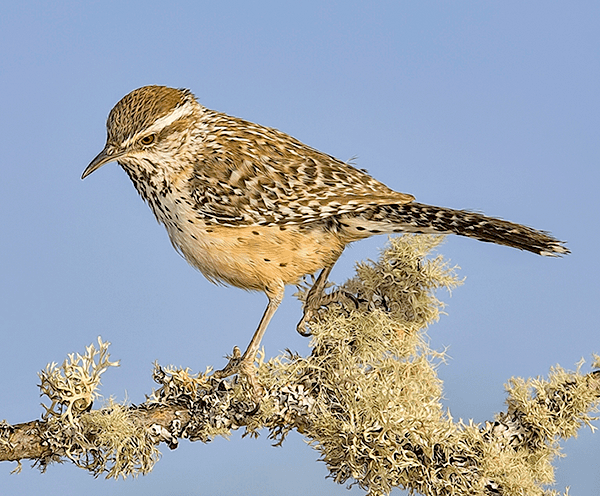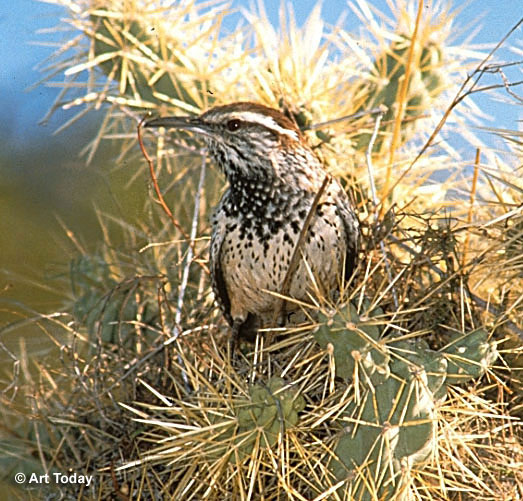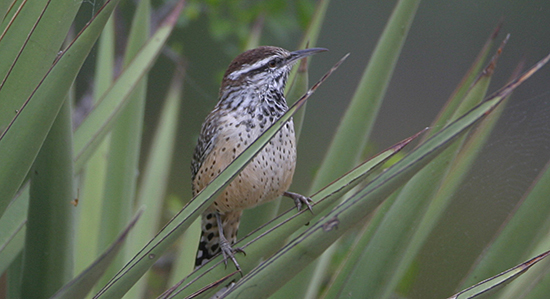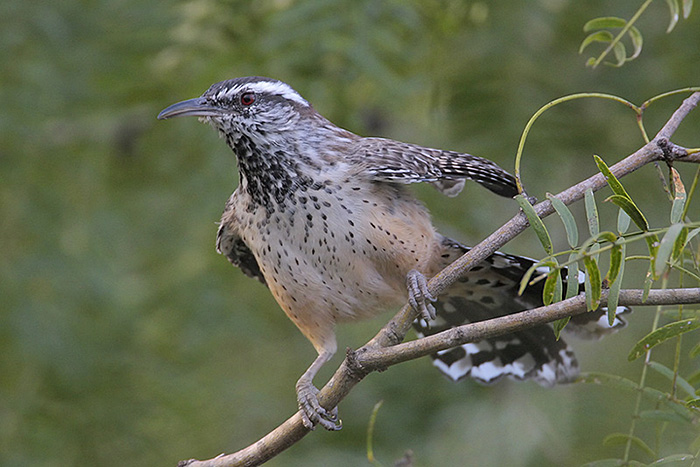The Cactus Wren is one of the US’s largest and most remarkable wrens. This contrastingly-colored bird is found in the arid habitats of the US Southwest and Mexico and is best known for its nesting habits – its chicks hatch in iconic desert cacti such as Cholla and Saguaro.
This species is different from other temperate-zone wrens. Although it has a typical thick, curved beak, it belongs to a group of tropical wrens bigger and more social than their northern cousins.
Since it’s quite a common bird across its range, you can observe it in family groups foraging for food in desert and scrubland habitats.
On this page
Breeding Male
The Cactus Wren’s body (any sex) is brown with dark brown speckles over the white chest and the wing’s edges. Contrastingly, the brown back is splashed with white streaks, and the sides have a cinnamon hue.
The head is brown with a white streak over the eye; the tail is black and white with a barred pattern and kept leveled (unlike other US wrens that keep it cocked). The beak is thick and visibly curved.

Photograph © Alan Wilson.
What is specific about males is they are more vocal than females, performing the typical, loud, “car-starting” song.
Also, they do territorial displays during the breeding season, marked by fluffing feathers, lowering and spreading their tale, and turning their bodies in half or quarter-circle.
Female
Females look the same as males – you can’t tell them apart by their colors.
However, they don’t perch and sing in the same pompous way as males; the song is much quieter and rarely heard at all.
Juvenile
Young birds have the same color patterns as adults but are paler. Also, they have brown eyes. Also, they vocalize with a quiet and imprecise warble.
Due to the stereotype that, in general, female birds are paler than males, juveniles are sometimes mistaken for females.
Wing shape
Cactus wren has rounded and relatively small wings. Besides flying, wings are often used when the bird is posturing.
Habitat
Not surprisingly, Cactus Wrens prefer habitats with a sufficient cover of spiny cacti, along with thorny desert shrubs, succulents, and trees such as mesquite and yucca. They are typically associated with the cholla cactus, their favorite nesting plant.

These wrens can also adapt to the conditions of arid towns, provided there is enough vegetation.
Diet
Insects make up the dominant part of the Cactus Wrens’ diet. In their home arid regions, their most common prey are ants, grasshoppers, beetles, and wasps.
Seeds and fruits are supplemental food but not a significant part of the daily menu.
The bird’s diet meets nearly all hydration needs. They rarely drink water, even when available.
When foraging, these birds are active, loud, and somewhat rowdy. They search for prey on the ground in small groups, often overturning the ground litter, leaves, and other objects. They also take to woody vegetation to find insects on leaves and branches.
The foraging usually begins late in the morning and continues at different times throughout the day. However, due to global warming, the activity now slows down in the hot afternoons.
Behavior
Cactus Wrens are fairly bold birds. They perch and posture, vocalizing loudly and openly. Groups hop around the ground or in the shrubs while searching for food and posture by spreading wings and tails.
They won’t approach humans but are not afraid either. Consequently, they often visit backyard feeders in arid regions, especially if there are suet and sunflower feeders or ground feeders with apple slices or bread.

Male Cactus Wrens are diligent defenders of their territory during the breeding season. A male will make lots of noise and chases to keep potential competitors away and will even destroy their nests if they happen to build them on his territory.
Range (and seasonal changes)
Cactus Wrens are found in southwestern deserts and scrublands, in both natural habitats and urban areas with native vegetation. They do not migrate but stay in their chosen territory year-round.
This is a widespread species but less commonly observed than you would expect. The US population counts around 3.1 million birds. Although not considered endangered, it is experiencing a decline due to habitat loss and environmental disruptions such as wildfires.
Fun Facts
- As a typical bird of southwestern deserts, the Cactus Wren became a symbol of a typical southwestern desert state; it has been an Arizona state bird ever since 1931.
- Nest building in spiny cacti and thorny shrubs is an adaptation to defend the nest against predators, including the Cactus Wren arch-enemies – whipsnakes (Masticophis sp.) that often prey on their eggs and chicks.
- Besides the primary nest, the male will often build six or more secondary nests that may or may not be abandoned. The female will choose the best and the coziest for additional broods. The less-comfy nets are used for roosting.
- The Cactus Wren’s scientific name describes its looks. The genus name Campylorhynchus comes from Greek and means “curved beak.” The second part of the name, capillus, means “hair” and refers to a specific brown “cap” marking on the head that looks like a hairstyle (a mullet!) if you put your imagination to it.
Vocalization
The raspy vocalization would probably make the musical house wren blush with embarrassment.
The song (if you can call it that) is rhythmic, unpolished, and grating. The Cactus Wren sound is most commonly compared to a car engine with trouble starting.
People Also Ask
What does a Cactus Wren look like?
A Cactus Wren looks a bit like an oversized temperate-zone wren – it has a typically curved beak and a round body shape, but unlike other wrens, it keeps its tail leveled rather than cocked. Its markings are striking, with dark brown and white streaks spattered over the lighter brown hues covering the body.
Where do Cactus Wrens make their nests?
Cactus Wrens make hefty, conspicuous, football-shaped nests on the desert vegetation – most notably, giant cacti such as Cholla and sometimes Saguaro.
Although they prefer the cacti, they have been observed to nest in desert trees and other vegetation.
After the breeding season, the wrens use the nests for nighttime roosting (sleeping).
What is the Cactus Wren known for?
It is best known for its desert-dwelling adaptation, nesting habits that include cacti, group foraging, bold behavior, and a highly unmusical song that sounds like a car engine (unsuccessfully) starting.
What do Cactus Wrens like to eat?
Cactus Wrens are mostly insectivorous, hunting for desert insects such as locusts, beetles, and ants on or near the ground. However, they’re not exclusive carnivores and will take fruits and seeds as an occasional treat.


Clay
Thursday 12th of October 2023
My wife rescued some baby birds that had their nest destroyed in a storm, and only one survived. We were going to release it, but it had bonded to us, so now we have a 6 month old cactus wren that lives with us. It mostly eats dried insects and cat food, but its favorite food is guacamole, and it always picks the onions and jalapeños out and eats them first.
Patrick O'Donnell
Friday 13th of October 2023
@Clay- Thanks for sharing your story! Ha ha, those Cactus Wrens are pretty smart.